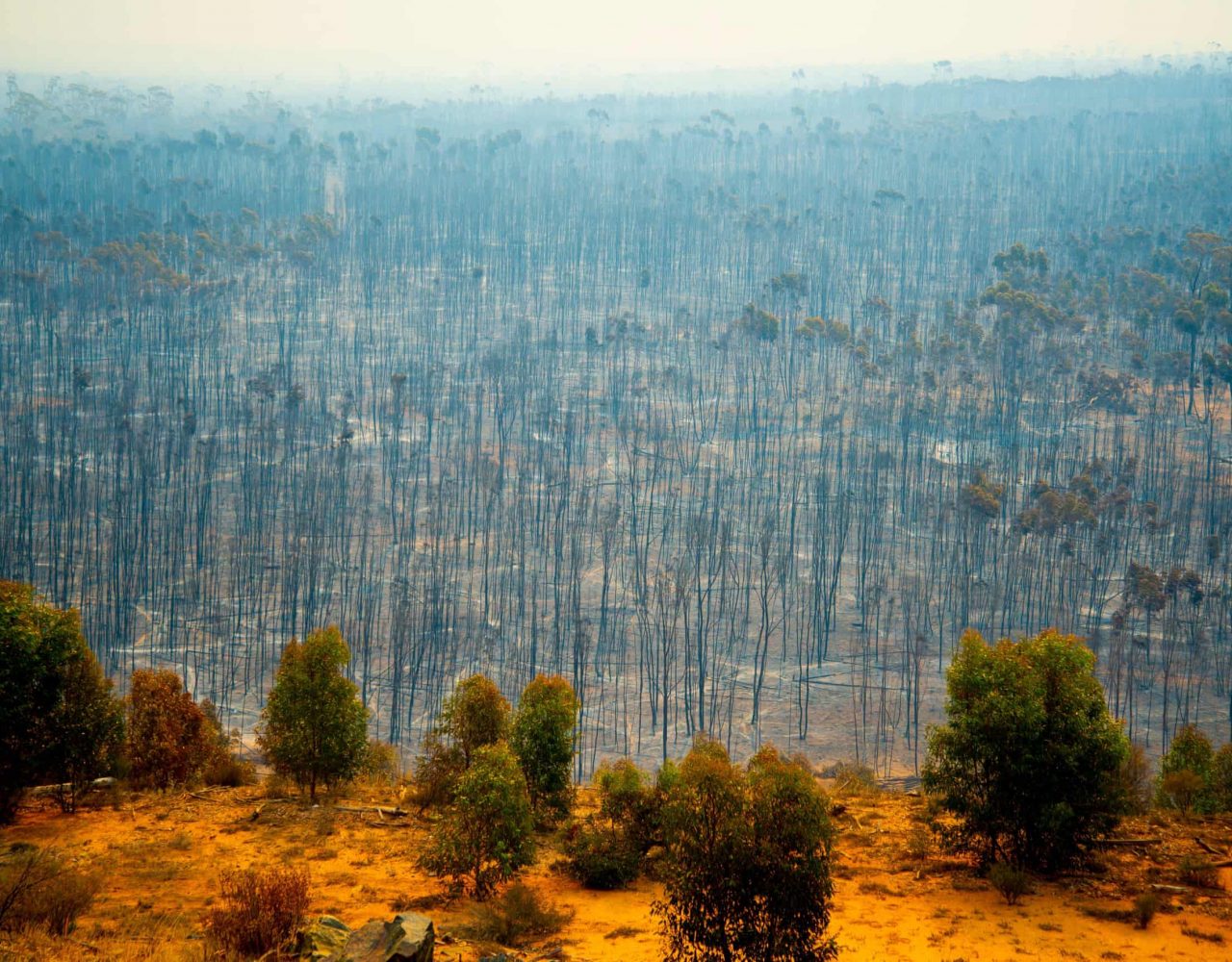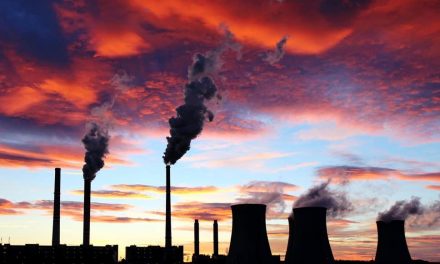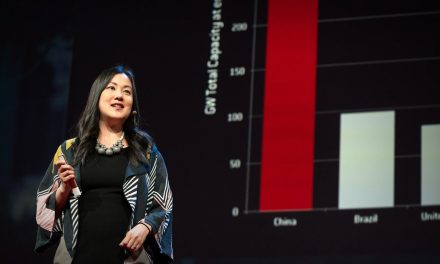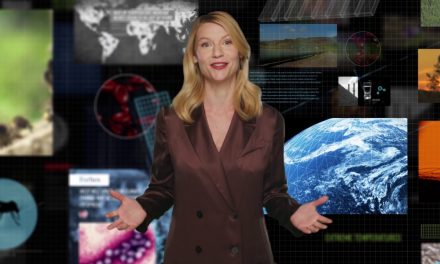Written by Joëlle Gergis / The Guardian
If you’ve ever been around someone who is dying, it may have struck you how strong a person’s lifeforce really is. When my dad was gravely ill, an invisible point of no return was gradually crossed, then suddenly death was in plain sight. We stood back helplessly, knowing that nothing more could be done, that something vital had slipped away. All we could do is watch as life extinguished itself in agonising fits and starts.
As a climate scientist watching the most destructive bushfires in Australian history unfold, I felt the same stomach-turning recognition of witnessing an irreversible loss.
The relentless heat and drought experienced during our nation’s hottest and driest year on record saw the last of our native forests go up in smoke. We saw terrified animals fleeing with their fur on fire, their bodies turned to ash. Those that survived faced starvation among the charred remains of their obliterated habitats.
During Australia’s Black Summer, more than 3 billion animals were incinerated or displaced, our beloved bushland burnt to the ground. Our collective places of recharge and contemplation changed in ways that we can barely comprehend. The koala, Australia’s most emblematic species, now faces extinction in New South Wales by as early as 2050.
Recovering the diversity and complexity of Australia’s unique ecosystems now lies beyond the scale of human lifetimes. What we witnessed was inter-generational damage: a fundamental transformation of our country.
Then, just as the last of the bushfires went out, recording-breaking ocean temperatures triggered the third mass bleaching event recorded on the Great Barrier Reef since 2016. This time, the southern reef – spared during the 2016 and 2017 events – finally succumbed to extreme heat. The largest living organism on the planet is dying.
As one of the dozen or so Australian lead authors involved in consolidating the physical science basis for the United Nations’ Intergovernmental Panel on Climate Change (IPCC) Sixth Assessment report, I’ve gained terrifying insight into the true state of the climate crisis and what lies ahead. There is so much heat already baked into the climate system that a certain level of destruction is now inevitable. What concerns me is that we may have already pushed the planetary system past the point of no return. That we’ve unleashed a cascade of irreversible changes that have built such momentum that we can only watch as it unfolds.
Australia’s horror summer is the clearest signal yet that our planet’s climate is rapidly destabilising. It breaks my heart to watch the country I love irrevocably wounded because of our government’s denial of the severity of climate change and its refusal to act on the advice of the world’s leading scientists.
I mourn all the unique animals, plants and landscapes that are forever altered by the events of our Black Summer. That the Earth as we now know it will soon no longer exist. I grieve for the generations of children who will only ever experience the Great Barrier Reef or our ancient rainforests through photographs or David Attenborough’s documentaries. In the future, his films will be like watching grainy archival footage of the Tasmanian tiger: images of a lost world.
As we live through this growing instability, it’s becoming harder to maintain a sense of professional detachment from the work that I do. Given that humanity is facing an existential threat of planetary proportions, surely it is rational to react with despair, anger, grief and frustration. To fail to emotionally respond to a level of destruction that will be felt throughout the ages feels like sociopathic disregard for all life on Earth.
To confront this monumental reality and then continue as usual would be like buying into a collective delusion that life as we know it will go on indefinitely, regardless of what we do. The truth is, everything in life has its breaking point. My fear is that the planet’s equilibrium has been lost; we are now watching on as the dominoes begin to cascade.
With just 1.1C of warming, Australia has already experienced unimaginable levels of destruction of its marine and land ecosystems in the space of a single summer. More than 20% of our country’s forests burnt in a single bushfire season. Virtually the entire range of the Great Barrier Reef cooked by one mass bleaching event. But what really worries me is what our Black Summer signals about the conditions that are yet to come. As things stand, the latest research shows that Australia could warm up to 7C above pre-industrial levels by the end of the century. If we continue along our current path, climate models show an average warming of 4.5C, with a range of 2.7–6.2C by 2100. This represents a ruinous overshooting of the Paris agreement targets, which aim to stabilise global warming at well below 2C, to avoid what the UN terms “dangerous” levels of climate change.
The revised warming projections for Australia will render large parts of our country uninhabitable and the Australian way of life unliveable, as extreme heat and increasingly erratic rainfall establishes itself as the new normal. Researchers who conducted an analysis of the conditions experienced during our Black Summer concluded “under a scenario where emissions continue to grow, such a year would be average by 2040 and exceptionally cool by 2060.”
We are the generation that is likely to witness the destruction of our Earth. ~Joëlle Gergis
It’s the type of statement that should jolt our nation’s leaders out of their delusional complacency. Soon we will be facing 50C summer temperatures in our southern capital cities, longer and hotter bushfire seasons, and more punishing droughts. We will be increasingly forced to shelter in our homes as dangerous heat and oppressive smoke become regular features of the Australian summer. Looking back from this future, the coronavirus lockdown of 2020 will feel like a luxury holiday.
Australia’s Black Summer was a terrifying preview of a future that no longer feels impossibly far away. We’ve experienced, first-hand, how unprecedented extremes can play out more abruptly and ferociously than anyone thought possible. Climate disruption is now a part of the lived experience of every Australian.
We are being forced to come to terms with the fact that we are the generation that is likely to witness the destruction of our Earth. We have arrived at a point in human history that I think of as the “great unravelling”. I never thought I’d live to see the horror of planetary collapse unfolding.
As an Australian on the frontline of the climate crisis, all I can do is try to help people make sense of what the scientific community is observing in real time. I use my writing to send out distress beacons to the wider world, hoping that processing the enormity of our loss through an international lens will help us feel the sting of it. Perhaps, then, we will finally acknowledge the terribly sad reality that we are losing the battle to protect one of the most extraordinary parts of our planet.
I often despair that everything the scientific community is trying to do to help avert disaster is falling on deaf ears. Instead, we hear the federal government announcing policies ensuring the protection of fossil fuel industries, justifying pathetic emission targets that will doom Australia to an apocalyptic nightmare of a future.

Recording-breaking ocean temperatures triggered the third mass bleaching event recorded on the Great Barrier Reef since 2016. Photograph: Greg Torda/ARC Centre Coral Reef Studies/EPA
The national conversation we urgently needed to have following our Black Summer never happened. Our collective trauma was sidelined as a deadly pandemic took hold. Instead of grieving our losses and agreeing on how to implement an urgent plan to safeguard our nation’s future, we became preoccupied by whether we had enough food in the pantry, whether our job or relationship would be intact on the other side of the lockdown. We were forced to consider life and death on an intensely personal level.
When our personal safety is threatened, our capacity to handle the larger existential threat of climate change evaporates. But just because we can’t face something doesn’t mean it disappears.
As many trauma survivors will tell you, it’s often the lack of an adequate response in the aftermath of a traumatic event, rather than the experience itself, that causes the most psychological damage. And if there is no acknowledgment of the damage that has been done, no moral consequences for those responsible, it’s as if the trauma never happened.
How can we ever re-establish trust in the very institutions that let things get this bad? How do we live with the knowledge that the people who are meant to keep us safe are the very ones allowing the criminal destruction of our planet to continue?
Perhaps part of the answer lies in TS Eliot’s observation that “humankind cannot bear very much reality”. To shy away from difficult emotions is a very natural part of the human condition. We are afraid to have the tough conversations that connect us with the darker shades of human emotion.
We are often reluctant to give voice to the painful feelings that accompany a serious loss, like the one we all experienced this summer. We quickly skirt around complex emotions, landing on the safer ground of practical solutions like renewable energy or taking personal action to feel a sense of control in the face of far bleaker realities.
As more psychologists begin to engage with the topic of climate change, they are telling us that being willing to acknowledge our personal and collective grief might be the only way out of the mess we are in. When we are finally willing to accept feelings of intense grief – for ourselves, our planet, our kids’ futures – we can use the intensity of our emotional response to propel us into action.
Grief is not something to be pushed away; it is a function of the depth of the attachment we feel for something, be it a loved one or the planet. If we don’t allow ourselves to grieve, we stop ourselves from emotionally processing the reality of our loss. It prevents us from having to face the need to adapt to a new, unwelcome reality.
Unfortunately, we live in a culture where we actively avoid talking about hard realities; darker parts of our psyche are considered dysfunctional or intolerable. But trying to be relentlessly cheerful or stoic in the face of serious loss just buries more authentic emotions that must eventually come up for air.
As scientists, we are often quick to reach for more facts rather than grapple with the complexity of our emotions. We think that the more people know about the impacts of climate change, surely the more they will understand how urgent our collective response needs to be. But as the long history of humanity’s inability to respond to the climate crisis has shown us, processing information purely on an intellectual level simply isn’t enough.
It’s something Rachel Carson – the American ecologist and author of Silent Spring, the seminal book warning the public about the dangerous long-term effects of pesticides – recognised nearly 60 years ago. She wrote: “It is not half so important to know as to feel … once the emotions have been aroused – a sense of the beautiful, the excitement of the new and unknown, a feeling of sympathy, pity, admiration or love – then we wish for knowledge about the object of our emotional response. Once found, it has lasting meaning.” In other words, there is great power and wisdom in our emotional response to our world. Until we are prepared to be moved by the profoundly tragic ways we treat the planet and each other, our behaviour will never change.
On a personal level, I wonder what to do in the face of this awareness. Should I continue to work my guts out, trying to produce new science to help better diagnose what’s going on? Do I try to teach a dejected new generation of scientists to help fix the mess humanity has made? How can I reconcile my own sense of despair and exhaustion with the need to stay engaged and be patient with those who don’t know any better?
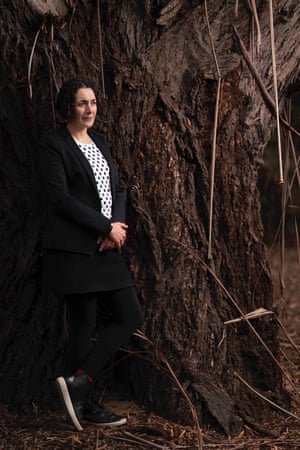
Joëlle Gergis: ‘Something inside me feels like it has snapped, as if some essential thread of hope has failed.’ Photograph: Lannon Harley/ANU
While I hope this will be the summer that changes everything, my rational mind understands that governments like ours are willing to sacrifice our planetary life-support system to keep the fossil fuel industry alive for another handful of decades. I am afraid that we don’t have the heart or the courage to be moved by what we saw during our Black Summer.
Increasingly I am feeling overwhelmed and unsure about how I can best live my life in the face of the catastrophe that is now upon us. I’m anxious about the enormity of the scale of what needs to be done, afraid of what might be waiting in my inbox. Something inside me feels like it has snapped, as if some essential thread of hope has failed. The knowing that sometimes things can’t be saved, that the planet is dying, that we couldn’t get it together in time to save the irreplaceable. It feels as though we have reached the point in human history when all the trees in the global common are finally gone, our connection to the wisdom of our ancestors lost forever.
As a climate scientist at this troubled time in human history, my hope is that the life force of our Earth can hang on. That the personal and collective awakening we need to safeguard our planet arrives before even more is lost. That our hearts will lead us back to our shared humanity, strengthening our resolve to save ourselves and our imperilled world.
• This essay will be part of the anthology Fire, Flood and Plague, edited by Sophie Cunningham and published by Penguin Random House in December

